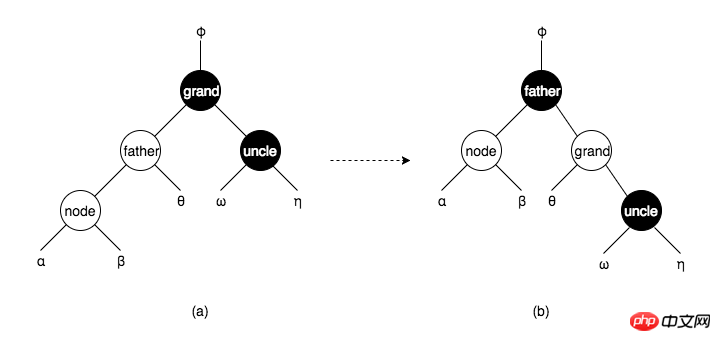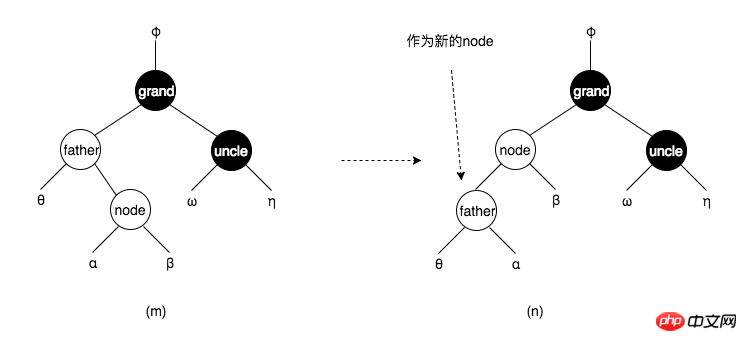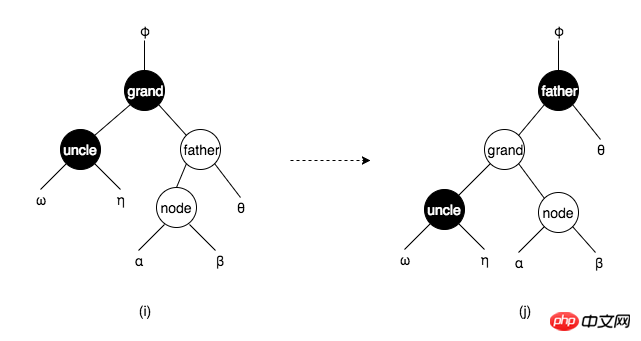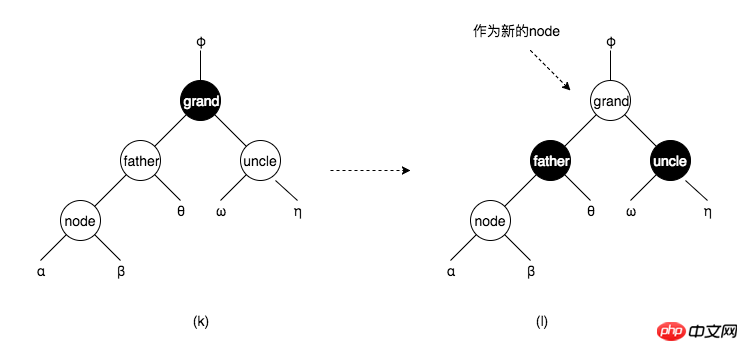
This time I will bring you a detailed explanation of the steps to implement a red-black tree with JS. What are the precautions for implementing a red-black tree with JS. The following is a practical case, let's take a look.
Properties of red-black trees
A binary search tree that satisfies the following properties is a red-black tree
Each node is either black or red.
The root node is black.
Each leaf node (NIL) is black.
If a node is red, both of its child nodes are black.
For each node, the simple path from the node to all its descendant leaf nodes contains the same number of black nodes.
Property 1 and Property 2 don’t need to be explained too much.

Property 3, each leaf node (NIL) is black. The leaf nodes here do not refer to nodes 1, 5, 8, and 15 in the above figure, but to the nodes with null values in the figure below. Their color is black and they are the child nodes of their parent nodes. .

Property 4, if a node is red (white is used instead of red in the figure), then its two child nodes are black, such as node 2 ,5,8,15. However, if both child nodes of a node are black, the node may not be red, such as node 1.
Property 5, for each node, the simple path from the node to all its descendant leaf nodes contains the same number of black nodes. For example, on the simple path from node 2 to all its descendant leaf nodes, the number of black nodes is 2; on the simple path from root node 11 to all its descendant leaf nodes, the number of black nodes is 2. is 3.
What are the characteristics of such a tree?
By constraining the color of each node on any simple path from the root to the leaf node, the red-black tree ensures that no one path is better than the other The path is twice as long because it is approximately balanced. ——"Introduction to Algorithms"
Due to property 4, two red nodes will not be adjacent in a red-black tree. The shortest possible path in the tree is the path with all black nodes, and the longest possible path in the tree is the path with alternating red nodes and black nodes. Combined with property 5, each path contains the same number of black nodes, so the red-black tree ensures that no path will be twice as long as other paths.
Insertion of red-black tree
First insert the node in a binary search tree and color it red. If it is black, it will violate property 5 and is inconvenient to adjust; if it is red, it may violate property 2 or property 4. It can be restored to the properties of a red-black tree through relatively simple operations.
After a node is inserted in a binary search tree, the following situations may occur:
Scenario 1
Inserting a node Finally, there is no parent node, and the node is inserted to become the root node, which violates property 2. The node is adjusted to black and the insertion is completed.
Case 2
After inserting a node, its parent node is black, and does not violate any properties. No adjustment is required, and the insertion is completed. For example, insert node 13 in the figure below.

Case 3
After inserting a node, its parent node is red, which violates property 4 and requires a series of adjustments. For example, insert node 4 in the figure below.

#So what are the series of adjustments?
If the parent node father of the inserted node node is red, then the node father must have a black parent node grandfather, because if the node father does not have a parent node, it is the root node. point, and the root node is black. Then the other child node of the node grandfather can be called the node uncle, which is the sibling node of the node father. The node uncle may be black or red.
Let’s analyze the simplest situation first, because complex situations can be transformed into simple situations. The simple situation is the situation where the node uncle is black.

Scenario 3.1
As shown in (a) above, the situation is like this, node is red, father is red, grandfather and uncle are black, α , β, θ, ω, and η are all subtrees corresponding to the nodes. Assume that in the entire binary search tree, only node and father cannot become a normal red-black tree due to violation of property 4. At this time, adjusting picture (a) to picture (b) can restore it to a normal red-black tree. The entire adjustment process is actually divided into two steps, rotation and color change.
What is rotation?

The above picture (c) is part of a binary search tree, where x, y are nodes, α, β, θ are the subtrees of the corresponding nodes . It can be seen from the figure that α < x < β < y < θ , that is, all nodes in the α subtree are smaller than The values of all nodes are less than the value of node y, and the value of node y is less than all nodes in the θ subtree. In a binary search tree, if the value of node y is greater than the value of node x, then node x is in the left subtree of node y, as shown in Figure (c); or node y is in the left subtree of node x In the right subtree, as shown in Figure (d). Therefore, α < x < β < y < θ can also be expressed by the structure of figure (d). This is rotation, which does not destroy the properties of binary search trees.
Node is red, father is red, grandfather and uncle are black. Specific situation 1
In Figure (a), node is the left child node of father, and father is the left child of grand. Node, node < father < θ < grand < uncle. In this case, father < grand, it can be expressed as father is the left subtree of grand, or it can be expressed as grand is the right subtree of father. Therefore, father and grand in figure (a) are rotated. Although the rotation will not destroy The properties of a binary search tree, but after rotation, the properties of a red-black tree will be destroyed, so the color of the nodes needs to be adjusted.
Color change
So after the picture (a) is rotated, grand should be changed to red, father should be changed to black, and it should be changed into picture (b) to complete the insertion.
Node is red, father is red, grandfather and uncle are black. Specific situation 2
node is the right child node of father, and father is the right child node of grand, as shown below ( e), is the reversal of specific situation 1.




To sum up
| node situation | Operation | |
|---|---|---|
| Case 1 | Node is red, no father | Recolor node |
| Case 2 | Node is Red, father is black | |
| node, father is red, grand, uncle is black | Rotate once Or twice, and recolor | |
| node,father,uncle is red and grand is black | Change father,uncle,grand Recolor, grand as new node |
// 结点
function Node(value) {
this.value = value
this.color = 'red' // 结点的颜色默认为红色
this.parent = null
this.left = null
this.right = null
}
function RedBlackTree() {
this.root = null
}
RedBlackTree.prototype.insert = function (node) {
// 以二叉搜索树的方式插入结点
// 如果根结点不存在,则结点作为根结点
// 如果结点的值小于node,且结点的右子结点不存在,跳出循环
// 如果结点的值大于等于node,且结点的左子结点不存在,跳出循环
if (!this.root) {
this.root = node
} else {
let current = this.root
while (current[node.value <= current.value ? 'left' : 'right']) {
current = current[node.value <= current.value ? 'left' : 'right']
}
current[node.value <= current.value ? 'left' : 'right'] = node
node.parent = current
}
// 判断情形
this._fixTree(node)
return this
}
RedBlackTree.prototype._fixTree = function (node) {
// 当node.parent不存在时,即为情形1,跳出循环
// 当node.parent.color === 'black'时,即为情形2,跳出循环
while (node.parent && node.parent.color !== 'black') {
// 情形3
let father = node.parent
let grand = father.parent
let uncle = grand[grand.left === father ? 'right' : 'left']
if (!uncle || uncle.color === 'black') {
// 叶结点也是黑色的
// 情形3.1
let directionFromFatherToNode = father.left === node ? 'left' : 'right'
let directionFromGrandToFather = grand.left === father ? 'left' : 'right'
if (directionFromFatherToNode === directionFromGrandToFather) {
// 具体情形一或二
// 旋转
this._rotate(father)
// 变色
father.color = 'black'
grand.color = 'red'
} else {
// 具体情形三或四
// 旋转
this._rotate(node)
this._rotate(node)
// 变色
node.color = 'black'
grand.color = 'red'
}
break // 完成插入,跳出循环
} else {
// 情形3.2
// 变色
grand.color = 'red'
father.color = 'black'
uncle.color = 'black'
// 将grand设为新的node
node = grand
}
}
if (!node.parent) {
// 如果是情形1
node.color = 'black'
this.root = node
}
}
RedBlackTree.prototype._rotate = function (node) {
// 旋转 node 和 node.parent
let y = node.parent
if (y.right === node) {
if (y.parent) {
y.parent[y.parent.left === y ? 'left' : 'right'] = node
}
node.parent = y.parent
if (node.left) {
node.left.parent = y
}
y.right = node.left
node.left = y
y.parent = node
} else {
if (y.parent) {
y.parent[y.parent.left === y ? 'left' : 'right'] = node
}
node.parent = y.parent
if (node.right) {
node.right.parent = y
}
y.left = node.right
node.right = y
y.parent = node
}
}
let arr = [11, 2, 14, 1, 7, 15, 5, 8, 4, 16]
let tree = new RedBlackTree()
arr.forEach(i => tree.insert(new Node(i)))
debugger
I believe you have mastered the method after reading the case in this article. For more exciting information, please pay attention to php Chinese website Other related articles!
Recommended reading:
js deduplication and optimization of numerical arraysDetailed explanation of the steps to globally introduce bass.scss into Vue The above is the detailed content of Detailed explanation of the steps to implement red-black tree in JS. For more information, please follow other related articles on the PHP Chinese website!




